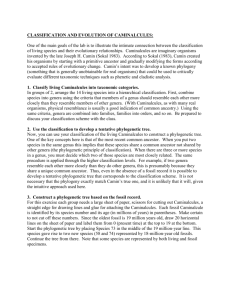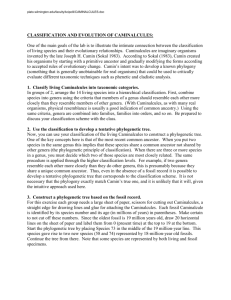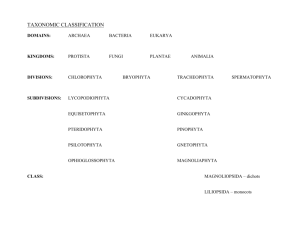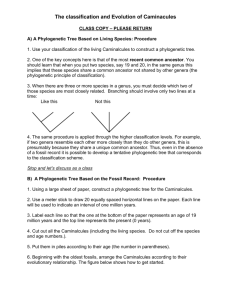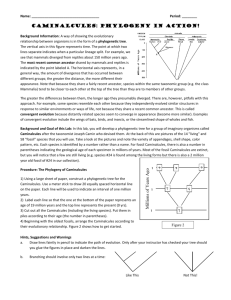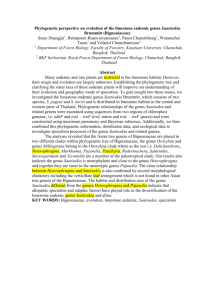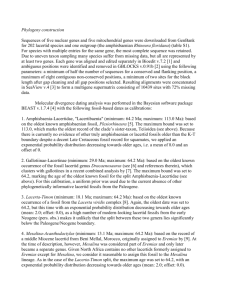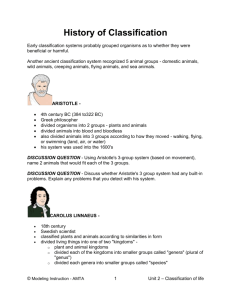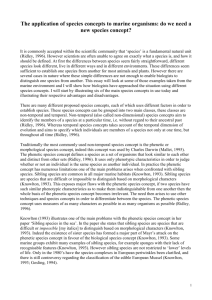Lab: Taxonomy of the Caminalcules - NatronaBiology-IB2
advertisement
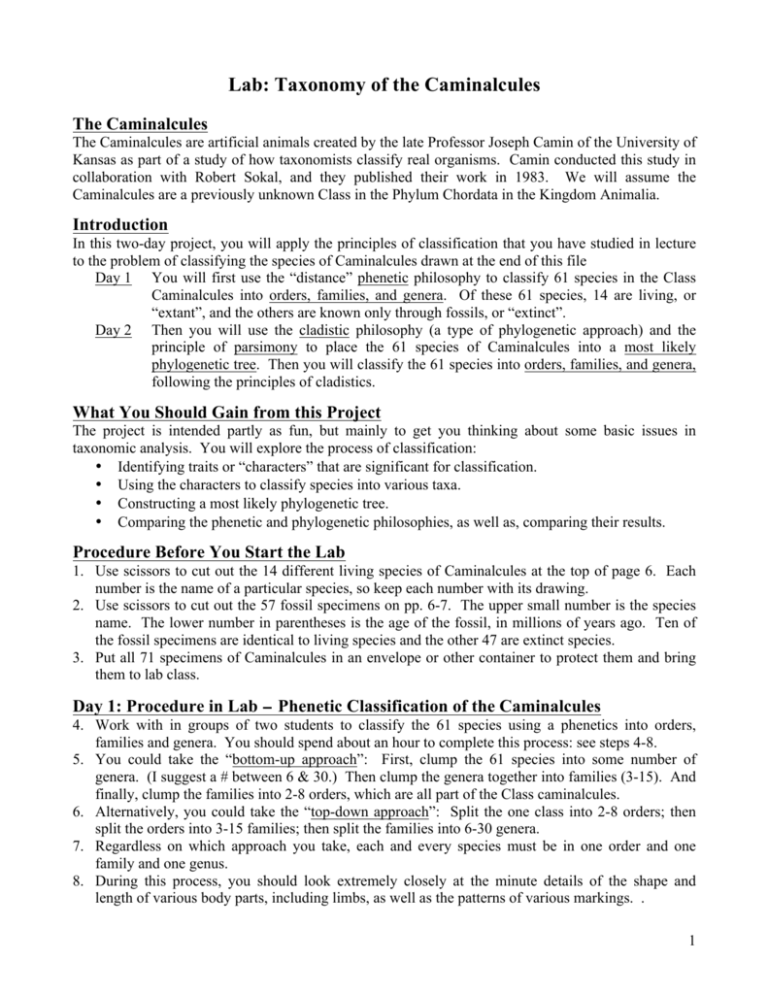
Lab: Taxonomy of the Caminalcules The Caminalcules The Caminalcules are artificial animals created by the late Professor Joseph Camin of the University of Kansas as part of a study of how taxonomists classify real organisms. Camin conducted this study in collaboration with Robert Sokal, and they published their work in 1983. We will assume the Caminalcules are a previously unknown Class in the Phylum Chordata in the Kingdom Animalia. Introduction In this two-day project, you will apply the principles of classification that you have studied in lecture to the problem of classifying the species of Caminalcules drawn at the end of this file Day 1 You will first use the “distance” phenetic philosophy to classify 61 species in the Class Caminalcules into orders, families, and genera. Of these 61 species, 14 are living, or “extant”, and the others are known only through fossils, or “extinct”. Day 2 Then you will use the cladistic philosophy (a type of phylogenetic approach) and the principle of parsimony to place the 61 species of Caminalcules into a most likely phylogenetic tree. Then you will classify the 61 species into orders, families, and genera, following the principles of cladistics. What You Should Gain from this Project The project is intended partly as fun, but mainly to get you thinking about some basic issues in taxonomic analysis. You will explore the process of classification: • Identifying traits or “characters” that are significant for classification. • Using the characters to classify species into various taxa. • Constructing a most likely phylogenetic tree. • Comparing the phenetic and phylogenetic philosophies, as well as, comparing their results. Procedure Before You Start the Lab 1. Use scissors to cut out the 14 different living species of Caminalcules at the top of page 6. Each number is the name of a particular species, so keep each number with its drawing. 2. Use scissors to cut out the 57 fossil specimens on pp. 6-7. The upper small number is the species name. The lower number in parentheses is the age of the fossil, in millions of years ago. Ten of the fossil specimens are identical to living species and the other 47 are extinct species. 3. Put all 71 specimens of Caminalcules in an envelope or other container to protect them and bring them to lab class. Day 1: Procedure in Lab − Phenetic Classification of the Caminalcules 4. Work with in groups of two students to classify the 61 species using a phenetics into orders, families and genera. You should spend about an hour to complete this process: see steps 4-8. 5. You could take the “bottom-up approach”: First, clump the 61 species into some number of genera. (I suggest a # between 6 & 30.) Then clump the genera together into families (3-15). And finally, clump the families into 2-8 orders, which are all part of the Class caminalcules. 6. Alternatively, you could take the “top-down approach”: Split the one class into 2-8 orders; then split the orders into 3-15 families; then split the families into 6-30 genera. 7. Regardless on which approach you take, each and every species must be in one order and one family and one genus. 8. During this process, you should look extremely closely at the minute details of the shape and length of various body parts, including limbs, as well as the patterns of various markings. . 1 9. Now record the results of your classification, producing a written document to submit to the instructor before the beginning of the next period, following steps 9-20. 10. Give each order a name based on its morphology (appearance). For example, if each species in the order had 3 heads, you could name it “3-headed” or “tricephela”. Record the name of each order and list the numbers of each species in it. 11. Give each family a name based on its morphology. Record the name of each family and list the numbers of each species in it. 12. Give each genus a name. Record the name of each genus and list the numbers of each species in it. 13. Use the information to produce a phenetic tree diagram to represent your classification. For example: Class Caminalcules: all 61 species Order Tricephala: ______________ Family: _______ Genus: __ Genus: __ Family: _______ Genus: __ Order Bidigita: __________________________ Family: _______ Genus: __ Genus: __ Family: _______ Genus: __ Genus: __ Family: _______ Genus: __ Explain your phenetic classification in writing: 14. Describe what traits distinguish species of your first order from members of all the other orders. 15. Repeat for each order. 16. Describe what traits distinguish species of your first family from members of all the other families in that order. 17. Repeat for each family. 18. Describe what traits distinguish species of your first genus from members of all the other genera in that family. 19. Repeat for each genus. 20. Each group of 2 students should submit to the instructor one copy of the phenetic tree (step 13) and the descriptions in steps 14-19. Each student should also keep a copy for her/himself. 21. I general, there is no one correct phenetic classification for any complex set of species. But some classifications are better than others. You will be graded on the degree to which your classification makes sense and the quality of your explanation. 22. Save the 71 Caminalcule cutouts for Day 2. 2 Day 2: Phylogenetic Classification of the Caminalcules: Goals: • To create a most likely phylogenetic tree, assuming that the Caminalcules evolved from a common ancestor, using the principle of parsimony. • To classify the 61 Caminalcules species into orders, families and genera using cladistics. Directions: 1. Work in the same groups of 2 as in Day 1. 2. Assemble the 71 cut-out Caminalcules, sorted in groups of different ages, indicated in the small lower numbers in parentheses. 3. Get a large piece of paper from the instructor, about 1 meter or 1 yard long. 4. Orient the paper so that the longer dimension goes from bottom to top. 5. Use a meter stick to draw 20 equally spaced horizontal lines on the paper. Each line will be used to indicate an interval of one million years. Label each line so that the one at the bottom of the paper represents an age of 19 million years and the top line represents the present (0 years). 6. Beginning with the oldest fossils, try to arrange the Caminalcules according to their evolutionary relationship, assuming the oldest fossil is a common ancestor to all of them. Figure 1 below shows how to get started. The oldest fossil is “73”, 19 mya. The two next oldest are “74” and “58”, both 18 mya. 17 Millions of Years Ago Figure 1 18 19 ? ? ? 7 4 5 8 7 3 bottom of the sheet Hints, Suggestions and Warnings for Creating your Phylogenetic Tree a. Draw lines faintly in pencil to indicate the path of evolution. Only after your instructor has checked your tree should you glue the figures in place and darken the lines. b. Branching should involve only two lines at a time: Like this Not this Like This c. NOT Like This Some living species are also found in the fossil record. 3 d. There are gaps in the fossil record for some lineages. Also, some species went extinct without leaving any descendants. f. There is only one completely correct phylogenetic tree in this exercise. This is the pathway that Joseph Camin set down for his imaginary animals. He started with the most primitive form (#73) and gradually modified it using a process that mimics how biologists think macroevolution occurred in real organisms. Directions Continued 7. After you complete your phylogenetic tree, classify the 61 species of Caminalcules into orders, families, and genera, using either a top-down or bottom-up approach. Remember, according to cladistics, all your taxa must be ______phyletic groups. 8. When you are sure of your classification, draw a pencil line around each taxon and label it. Draw copies of your tree and taxa on a 8 ½” × 11” sheet for each student. You will need them to complete the worksheet and report below. Submit your large original phylogenetic tree and cladistic classification to the instructor by the end of the Day 2 lab period. 9. Worksheet: Each group will complete the worksheet on p. 5. Due Fri 2 Feb by 5pm. 10. Lab Report: NOT the usual lab report format. Each group will write an essay in which you compare and contrast your group’s phenetic classification to your cladistic classification. Are they completely different? Or are some taxa very similar and others not so similar? Or are they the same? Which of the two do you prefer and why? Due Fri 9 Feb by 5pm. Typed. Essay format. 4 Questions to Think About, Answer & Submit M 6 Feb 1pm Names in Group ______________ 1. The horseshoe crab and cockroach are real living animals that have changed very little in the fossil record over many millions of years. For this reason, we call these animals “living fossils”. Which Caminalcule lineages have changed very little over many millions of years? What ecological conditions might have caused this sort of long-term evolutionary stasis? 2. On the other hand, what Caminalcule lineages branched many times and are represented by many living species? Discuss the ecological conditions that you think might have caused the rapid diversification of those Caminalcule lineages. 3. What Caminalcule species went extinct without leaving descendents? What factors might have caused those species to become extinct? 4. Describe two examples of convergent evolution among the Caminalcules. Write your answers in complete sentences (e.g. “Species x and y both have ____ but their most recent common ancestor, z, did not”). List two additional real-world examples of convergent evolution (ones that we have not already talked about in class) and discuss what might have caused the convergence. 5. Describe two examples of vestigial structures that you can find among the Caminalcules. These are structures that have been reduced to the point that they seem to be virtually useless. Include the # of the species in your descriptions. Explain how vestigial structures provided clues that helped you construct the phylogeny of the Caminalcules. 5 LIVING CAMINALCULES FOSSIL CAMINALCULES (numbers in parentheses indicate age in millions of years) FOSSILS (continued) 7
